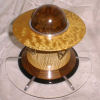I'm building a wagon vise with rails based on Benchcrafted design. To replicate effect of vise block riding on rails, I'm considering using a plate of 1/2 hard maple riding inside a rail sandwich made of 1/8" aluminum bars, sandwiching a 1/2" MDF bar, and screwed underneath the bench top.
I'm selecting aluminum because it is readily available straight and smooth, unlike steel. I don't fully understand forces that rails have to take. When vise is tightened, vise block will want to turn clockwise (if you are right-handed, looking from bench front). I am not sure if this rotation will first be stopped by the nut, or if there is enough play in the nut so that it will be stopped by the rail. I am using LV screw, and there is very little play in the nut, but there would probably be very little play in rails too. If rails have to withstand this force, it seems it would be considerable. If there is roughly equal distance between top of bench dog and nut, and nut and end of rail plate, there would be as much force pushing down on back and of rail and up on front end of rail as there is clamping force. If this analysis is correct, 1/8" aluminum may be strong enough. I don't think it would break, but I don't want it to give, or vise will probably feel mushy when tightening. In addition to this twisting force, centred around the nut, the whole screw will want to rotate upward centered on collar, but this is not a concern since it will just be pushing aluminum up into the solid bench. Any thoughts? Should I find 1/4" aluminum?




 Reply With Quote
Reply With Quote




